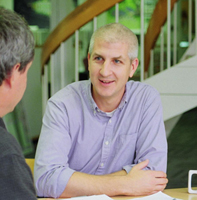Blogger’s Note: Today’s entry is a cross-posting from Sasaski Design.
Our world is changing in ways we could never have predicted.
As I fly to Chicago from Boston, I am leaving behind the tragic events of the Boston Marathon. Being in an airplane provides a calming sense of separation from all the activity 30,000 feet below me, though the escapist feeling quickly fades as I open up my laptop and get to work. Before long, I’ll be back on the ground and tomorrow, I’ll be presenting at the national planning conference in Chicago.
I wait for the computer to boot up, and I think about my life as a planner—how it requires me to embrace change and translate it into action so that our communities can adapt and thrive. Planners aren’t allowed to be escapists. We must be pragmatic, logical, and ethical.
My presentation at the American Planning Association conference focuses on the reemergence of regional planning in the United States. This is thanks in large part to the Partnership for Sustainable Communities, which brings together three major federal agencies: the Department of Housing and Urban Development (HUD), the Department of Transportation (DOT), and the Environmental Protection Agency (EPA). In 2010 and 2011, the program issued 152 grants worth a total of $240 million in 48 states, in which 133 million Americans live.
And while these numbers may sound impressive, they pale in comparison to the 2009 American Recovery and Reinvestment Act. That program spent $93 billion in total, with 53% of that amount going to highway and bridge construction and repair alone. Not only is that figure 400 times as much as has been spent on planning, it was allocated before any regional planning was done—in essence, putting the cart before the before the horse. And only now, through the regional planning grant program, are we beginning to fully comprehend the negative impacts of transportation spending on our communities.
 One way of understanding the adverse impacts of building more roads is to look at the cumulative costs of housing and transportation on the average household. Under the conventional definition of housing affordability (30% or less of household income), 69% of U.S. communities have average household costs that are considered to be “affordable.” However, when housing and transportation costs are considered together, only 40% of our communities are truly affordable.
One way of understanding the adverse impacts of building more roads is to look at the cumulative costs of housing and transportation on the average household. Under the conventional definition of housing affordability (30% or less of household income), 69% of U.S. communities have average household costs that are considered to be “affordable.” However, when housing and transportation costs are considered together, only 40% of our communities are truly affordable.
Even more distressing is the fact that low-to-moderate income households are impacted more by housing plus transportation costs than those at higher income levels. For moderate income families ($44,500 total household income) in the 25 largest metropolitan areas, their combined housing and transportation costs are 59% of their total income. It’s hard to see a sustainable future in these facts.
This is where good planning can make a real difference. Had the timeline been reversed, and the HUD/DOT/EPA grant program been initiated before the Recovery Act, I believe we would have invested differently in our country.
Perhaps we could have found new ways to define and promote economic development in our cities. Instead of building new highway interchanges to stimulate development, we could have spent time finding new ways to repurpose former industrial areas that tend to be very well served by infrastructure but suffer from disinvestment and population decline. We could have focused on job training to establish a more competitive labor pool that would attract businesses and spur innovation.
And perhaps we still will.
It appears that the next wave of funding through the Sustainable Communities Partnership will finally be focused squarely on economic development. The Integrated Planning and Investment Grants (proposed $75 million for next year) will fall under a new office—the Office of Economic Resilience—which will be housed within the Office of Community Planning and Development. This new wave of planning grants is focused on creating more economic opportunities with an emphasis on economic resiliency and implementation.
How this will all affect infrastructure spending and other federal programs remains to be seen. But there is reason to be hopeful, and planning is more relevant now than ever before.
As my plane begins its descent to Chicago, I add one final slide to my presentation addressing the topic of change:
“If we want things to stay as they are, things will have to change.”
—Giuseppe Tomasi di Lampedusa, The Leopard
 James Miner is a planner with significant national experience in mixed-use real estate development, new communities, urban districts, and long-term strategic and physical planning for institutions and higher education campuses. He is currently the Director of Planning and Urban Design as Sasaki Associates and the Principal-in-Charge of The Tomorrow Plan.
James Miner is a planner with significant national experience in mixed-use real estate development, new communities, urban districts, and long-term strategic and physical planning for institutions and higher education campuses. He is currently the Director of Planning and Urban Design as Sasaki Associates and the Principal-in-Charge of The Tomorrow Plan.



